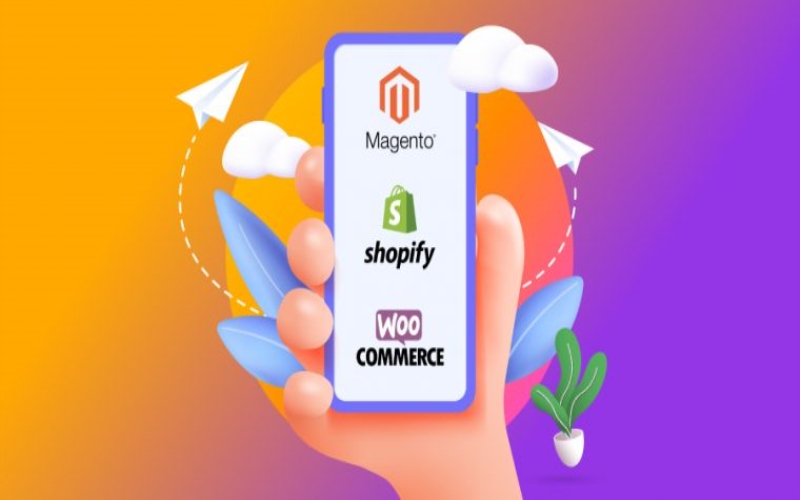Selecting the right eCommerce platform is one of the most critical decisions for online businesses. The platform shapes everything from user experience and store customization to backend management and scalability. With global eCommerce sales projected to surpass $7.5 trillion by 2025, competition is more intense than ever, making the platform choice even more essential for business success.
Among the numerous options, WooCommerce, Shopify, and Magento stand out as the top choices for many online retailers. Each offers unique strengths, with WooCommerce known for its flexibility, Shopify celebrated for its simplicity, and Magento praised for its extensive customization capabilities. These platforms collectively power millions of businesses, supporting online stores of all sizes and sectors.
So, how do you choose the best one for your business needs? Let’s dive into the strengths of each to find the ideal fit for your eCommerce journey.
Platform Features Comparison
WooCommerce
WooCommerce is a WordPress-based eCommerce platform known for its flexibility and extensive customization options. Ideal for businesses that want to tailor their store’s functionality, WooCommerce offers thousands of plugins and themes, allowing store owners to extend features or design specific layouts. Its scalability also means that small businesses and growing enterprises alike can manage an evolving catalogue of products. WooCommerce’s open-source nature gives developers the freedom to make custom modifications, making it a popular choice for brands seeking a personalized online store experience.
Shopify
Shopify is an all-in-one, user-friendly platform praised for its simplicity and convenience. It is a fully hosted solution, meaning that Shopify handles hosting, security, and software updates, making it an excellent choice for businesses without a dedicated IT team. Shopify includes built-in tools for inventory management, payment processing, and order fulfilment, streamlining the setup process for online stores of all sizes. The platform also has a robust app marketplace, allowing merchants to add advanced features as needed. Shopify’s intuitive interface and customer support make it a preferred option for small businesses and entrepreneurs seeking rapid store setup and management.
Magento
Magento is designed with large, complex eCommerce operations in mind. Known for its powerful and robust feature set, Magento offers extensive customization options and multi-store capabilities, allowing businesses to manage multiple storefronts from a single admin panel. This platform is highly scalable and comes equipped with advanced SEO tools, detailed product catalogue management, and support for various languages and currencies, making it particularly suitable for international brands. However, Magento’s complexity requires more technical expertise, often making it a better choice for medium to large businesses with dedicated development resources.
In the WooCommerce vs Magento comparison, WooCommerce offers flexibility for small to medium businesses needing customization, while Magento is geared toward larger enterprises requiring robust, multi-store functionality.
Each platform offers distinct advantages, making the decision highly dependent on business size, budget, and technical needs. Understanding these features can guide you toward the best choice for your eCommerce goals.
Cost Analysis
Each platform—WooCommerce, Shopify, and Magento—has a unique pricing model, from upfront costs to ongoing expenses. Here’s a breakdown of the typical costs associated with each platform, helping businesses determine which solution best fits their budget.
WooCommerce
WooCommerce is technically free to use, but businesses need to budget for essential costs like hosting, domain registration, and additional plugins. Hosting costs can vary widely depending on provider and traffic requirements, with a typical range from $5 to $50+ per month. Domain registration averages around $10–$20 annually. At the same time, premium plugins and themes add flexibility. Still, they can also increase costs, especially if multiple paid extensions are required. WooCommerce offers flexibility in controlling expenses, allowing businesses to select only the tools they need and scaling costs according to their budget.
Shopify
Shopify offers tiered pricing plans, starting from $39 per month for the basic plan and going up to $399 per month for the advanced plan. Each tier provides additional features like detailed reports, lower transaction fees, and advanced shipping options. Shopify charges a transaction fee (ranging from 0.5% to 2%) if businesses don’t use Shopify Payments. Additionally, premium themes cost between $100 and $200, while third-party apps often carry monthly fees. While these add-ons can increase costs, Shopify’s pricing structure offers transparency, allowing businesses to predict expenses more accurately.
Magento
Magento’s cost structure differs significantly, with both a free, open-source version (Magento Open Source) and a paid version (Adobe Commerce). The open-source option requires a self-hosted setup, with costs for hosting, development, and security often totalling $100 to $500+ monthly, depending on server requirements. Adobe Commerce, Magento’s premium version, includes advanced features and managed hosting, but its license fees can range from $22,000 to over $125,000 per year, making it best suited for larger enterprises. Additionally, Magento often requires a professional developer to handle customization, increasing setup costs for complex stores.
WooCommerce is flexible with initial expenses, Shopify provides a predictable subscription model, and Magento’s open-source version can scale for businesses willing to invest in setup and maintenance. This comparison helps retailers match their budget with the right platform to support their growth goals.
Use Cases and Suitability
When choosing an eCommerce platform, it’s essential to consider each platform’s strengths and how they align with your business needs. WooCommerce, Shopify, and Magento each cater to different types of businesses, depending on factors like size, complexity, and technical resources.
WooCommerce
WooCommerce is an excellent fit for small to medium businesses with some technical knowledge or familiarity with WordPress. This platform offers high flexibility, allowing users to fully customize their online store’s design and functionality through thousands of plugins and themes. For example, a niche clothing brand that frequently updates its product catalogue and wants a unique website layout would find WooCommerce ideal. This flexibility and customization enable businesses to create tailored shopping experiences and keep costs manageable as they grow.
Shopify
Shopify is ideal for entrepreneurs, small businesses, and rapidly scaling mid-sized stores that prioritize ease of setup and maintenance. Its all-in-one approach and intuitive interface are designed for users with limited technical expertise, making it easy to launch and manage an online store quickly. An example of a good use case for Shopify is a boutique jewellery store that values quick setup, streamlined inventory management, and the ability to scale with minimal technical involvement. Shopify’s app ecosystem also allows for easy expansion of features without complex integrations.
Magento
Magento is suited for larger enterprises with complex needs, a substantial product catalogue, and in-house technical resources. Its robust functionality supports advanced features, multiple storefronts, and high levels of customization, making it a powerful choice for enterprise-level eCommerce. For instance, a multinational electronics retailer that needs separate storefronts for different regions, each with localized content, would benefit from Magento’s multi-store capabilities and extensive customization options. This platform offers the scalability and flexibility to manage large volumes of traffic and transactions, which is essential for high-demand online stores.
Each platform brings unique strengths, making it important to choose the one that aligns best with your business goals and resources.
Choosing the Right Platform for Your Business
Selecting the ideal eCommerce platform depends on your business’s unique needs, scale, and growth goals. WooCommerce, Shopify, and Magento each bring distinct strengths: WooCommerce is highly customizable and perfect for businesses already using WordPress or those wanting flexibility in design and functionality. Shopify, with its managed hosting and user-friendly interface, suits businesses looking for a quick, streamlined setup with built-in tools. Magento is ideal for large, complex businesses that require a powerful, scalable solution with multi-store capabilities and advanced customization.
However, while these platforms cover many needs, businesses with specialized requirements may benefit from a custom solution. Custom development allows for a fully tailored eCommerce experience that can adapt as your business evolves. With a custom-built platform, you’re not limited by preset templates or plugin compatibility issues. Instead, you can design and implement features that align directly with your workflow, brand experience, and customer needs.
For businesses looking to explore this path, a custom web development company COAX provides expert solutions for creating scalable, fully integrated eCommerce platforms that adapt to growth. With COAX, you can build a platform that not only fulfils current needs but also has the flexibility to incorporate new technologies, enhanced security, and other customized elements critical for long-term success.





